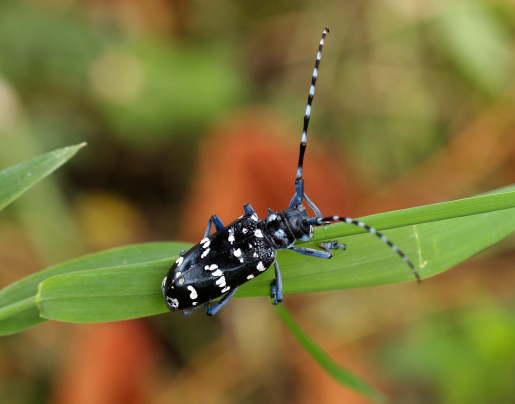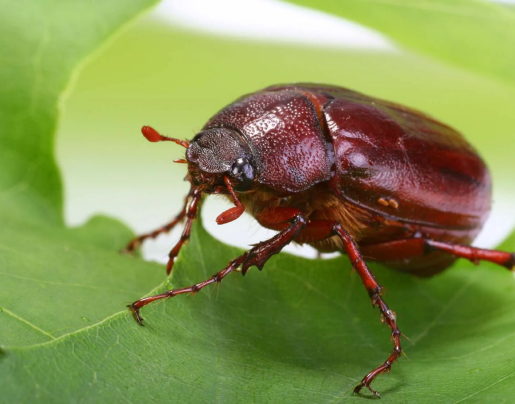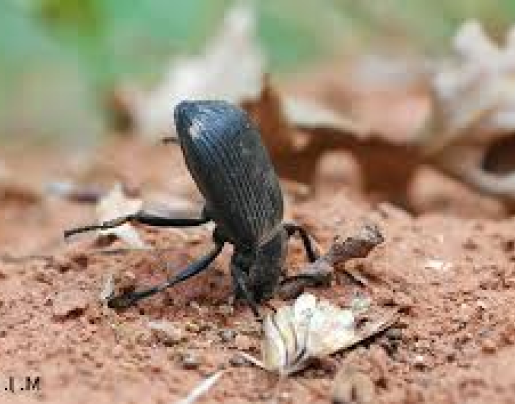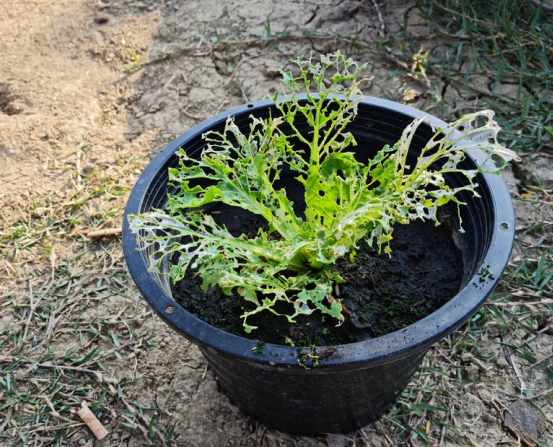Act Now - Limited Time Offer
$67 Pest Control

Ty Archer
Pest Control Technician
Chris Mosby
Pest Control Technician
Rob Adrain
Sales Representative
Billbugs are small beetles belonging to the weevil family, typically about 1/2 to 1 inch long. They are identified by their unique snouts, resembling miniature elephant trunks, and come in various shades of gray to brown. Their white, grub-like larvae, which are legless, live beneath the soil, feeding on plant stems and roots. These beetles commonly affect grasses and garden crops. Adults cut into plant stems to feed and lay their eggs, causing damage, while larvae continue feeding underground.
Billbugs typically produce one generation annually. Adults overwinter in leaf litter and lawn thatch before laying eggs in grass stems. The larvae hatch in one to three weeks, feeding on plant stems from the inside. If your grass or garden crops appear damaged, billbugs could be responsible. Regular inspections and early treatment can prevent serious infestations.


Blister beetles are soft-bodied insects measuring from 1 to 2.5 cm in length, appearing in a variety of colors from ash gray to bright yellow with black stripes. They produce cantharidin, a toxic chemical known for causing skin blisters. Once used medicinally, it is now rarely employed due to its toxicity.
Blister beetles primarily target crops, especially vegetable and ornamental plants, and pose a risk to livestock if present in hay. Regular field inspections and immediate removal of contaminated hay are crucial for preventing livestock from ingesting these pests.
Carpet beetles are small insects, around 1 to 4 mm long, with oval bodies and a distinct mix of black, white, and yellow coloring. The larvae, slightly larger than the adults, are covered with fine hairs and range from light brown to black. These pests can enter homes through windows, doors, or be carried inside with plants.
Carpet beetle larvae feed on animal-based items like wool, fur, leather, and silk, which can result in significant fabric damage. Females lay between 25 and 100 eggs in spring, with larvae hatching in two weeks. Proper cleaning and storage of vulnerable items are essential to avoid infestations.


The Citrus Longhorned Beetle threatens trees across Loomis. These beetles are shiny black with white spots and can grow up to 35mm long. They attack healthy trees, feeding on twigs and leaves, and burrowing into the wood to lay eggs. Signs of infestation include round holes in the trunk and sawdust at the base.
Effective control starts with a thorough inspection. Infested trees should be removed to prevent further spread. This pest, introduced from Asia, is harmful to trees like pecan, apple, pine, sycamore, and willow. Early detection is vital to keeping local trees safe.
Click beetles are frequently found throughout North America, recognized by their long bodies, which are black or brownish. Adults typically grow to a size between 1/2 and 1 inch. They are nocturnal and attracted to light but hide in dark places during the day.
Their larvae develop in soil, where they feed on seeds, plant roots, and small insects, potentially causing crop damage. When adult click beetles appear indoors, they are likely seeking shelter from colder temperatures or searching for food.


Lightning bugs, or fireflies, are a familiar summer sight, illuminating the evenings. The U.S. is home to around 200 species, mostly in warm areas near water. While they don’t bite, sting, or spread diseases, large gatherings can become a nuisance.
Their glow helps them attract mates, and they lay eggs in moist soil, where the larvae feed on small insects and worms. If fireflies are becoming overwhelming in your yard, Loomis Pest Control offers effective management solutions to reduce their numbers and make your outdoor space more comfortable.
Foreign grain beetles, which are about 2 to 3 mm long, are reddish-brown insects often found in grain storage areas but can also appear in moist locations like damp walls or humid bathrooms. These pests feed on dead insects, moldy grains, and fungi.
Preventing a foreign grain beetle infestation requires keeping storage spaces clean and dry. Contaminated food items should be discarded, and proper ventilation should be maintained to lower humidity. Regular cleaning and removal of damp materials can help stop their spread.


In Loomis and across the U.S., ground beetles are common insects. They are black, flat, and have elongated bodies that can range from 1/16 to 1 inch in length. They seek dark hiding spots during the day and become active at night, often scaling trees and other structures in search of food.
Ground beetles feed on various pests, including larvae, slugs, and snails, making them helpful in pest control. However, large populations can become bothersome. To avoid an infestation, reduce hiding places by clearing debris and sealing any gaps in your home.
With their metallic green bodies and bronze wings, Japanese beetles are highly destructive, attacking more than 300 types of plants. These beetles feast on foliage, leaving behind a “skeletonized” appearance, while their larvae feed on grass roots, damaging lawns.
Loomis Pest Control provides comprehensive Japanese beetle control, focusing on both the adults and larvae. We employ safe methods to protect your plants and ensure your garden stays in optimal condition.


June beetles, commonly called May bugs, are scarab beetles that appear in late spring and early summer. Adult June bugs are reddish-brown, and their clumsy flight often results in them hitting windows. Their larvae, also known as white grubs, are off-white, soft, and equipped with six legs and brown heads.
June bugs eat leaves, damaging plants and shrubs. The larvae feed on the roots of grass, leaving behind dry, bare patches in lawns. This damage can attract animals like moles and voles that dig up lawns to hunt for the larvae.
Asian Lady Beetles, about 7 mm in size, come in colors ranging from yellow to red with spots and have a noticeable “M” shaped mark behind their heads. They are beneficial as they feed on aphids and similar pests, but large numbers can invade homes, especially during cooler months.
Loomis Pest Control addresses this by sealing cracks and openings around entry points like windows and doors. We also use screens to keep these beetles out. Keeping areas free from leaf piles or debris near the home helps prevent them from nesting.


Darkling beetles, often referred to as stink beetles, are common in areas with decaying plants, sand, or under wood debris. These beetles typically range from 1/2 to 1 1/2 inches in size and are dark brown or black. They produce a foul odor when disturbed to fend off threats.
Loomis Pest Control handles stink beetle infestations by clearing away decaying vegetation and keeping outdoor spaces clean. We also make sure your home is sealed to prevent their entry. If you’re experiencing a stink beetle issue, contact us for swift and effective control services.
In Loomis, whitemarked spider beetles are identified by their light brown color and patches of white hair on their wings. These pests, which look like small spiders due to their long legs and rounded abdomens, grow to about 1/4 inch. They often feed on spoiled grains, cereals, and dried fruit.
They prefer damp environments and are frequently found in homes, food storage areas, and libraries. Females lay their eggs near food, and the larvae develop over the course of two to three months.

We start our beetle control service with a detailed inspection of your home. By identifying the specific beetle type and infestation level, we ensure that we apply the correct treatment.
After the inspection, we develop a customized treatment plan. We focus on both adult beetles and their larvae to eliminate the issue completely and safeguard your property from future damage.


Loomis Pest Control takes follow-up treatments seriously in eliminating beetles. After the initial treatment, we’ll return to assess the situation. This visit ensures the first treatment was successful and helps identify any remaining beetles or new signs of activity.
During the follow-up, we inspect the treated areas thoroughly. If needed, we perform additional treatments to address persistent issues. This step breaks the beetle life cycle, preventing future problems and ensuring your home remains protected.
Loomis Pest Control specializes in beetle prevention and monitoring. Our trained team inspects your home or business, checking for potential entry points and areas of infestation. We advise routine cleaning and proper food storage to minimize attractants.
By setting up traps during beetle season, we catch early signs of activity and respond quickly. Loomis Pest Control ensures that beetle problems are solved before they escalate, keeping your property safe all year round.


Serving Loomis and its nearby communities, we’re here to keep your spaces pest-free. Our team is passionate about these areas and always aims to deliver excellent service and proven results.
Limited time offer! Get $50 off your first pest control service.

Barrier Services
Loomis Office
© Loomis Pest Control 2024